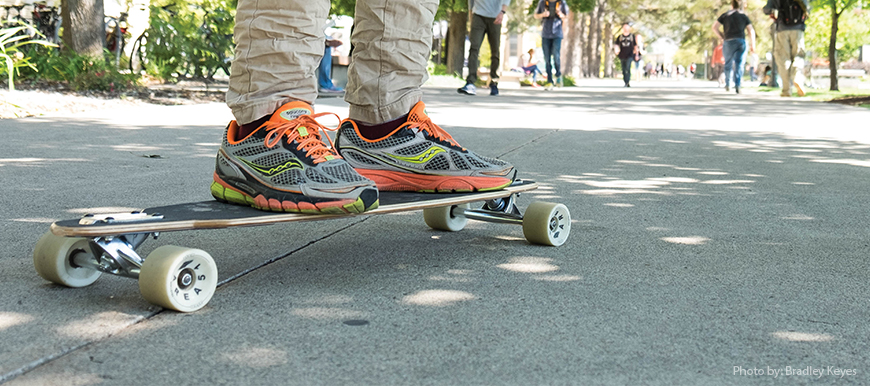Bikers, longboarders and pedestrians coexist on campus
As pedestrians meander around Utah State University, many recognize the rhythmic ka-chunk ka-chunk of a longboarder as they approach from behind.
Some students use their wheels — including longboards, bikes, skateboards and scooters — to navigate campus.
Aggie Blue Bikes employee Ashley Casperson said a lot of her classes this semester are all over campus, going from the Widtsoe Hall to the engineering and fine arts buildings.
“And with just 10 minutes in between class, you can’t really walk there,” Casperson said. “So biking is convenient. It’s quick. You get where you need to go.”
Jameson Daines, a junior in psychology, longboards around campus. While he said that longboarding is convenient, walking also has its benefits.
“With walking, you don’t have to pay attention as much. Especially in the morning, you can just kind of turn your brain off and just walk straight to class,” Daines said. “Whereas if you’re longboarding, you got to look out for people and just in general avoid things. It takes more energy.”
Avoiding collision is a concern shared by many students, whether they travel by feet or on wheels.
“I’ve had to slam on my breaks a couple times because, you know, people have their headphones in, and they’re not focused,” Casperson said. “You have to pay a lot of attention when you’re riding your bike.”
Daines said that this is true for longboarders as well, especially when they aren’t anticipated.
“Sometimes freshmen won’t get out of the way,” Daines said. “That is, like, a really common thread, because they just don’t know that there could be someone going fast behind you on a longboard. There’s also kind of swerving around people. I’m pretty good at it, I’d say.”
Jack Darrington, a freshman in economics, said that dodging wheels is part of a day in the life of a USU pedestrian.
“A couple times, I probably have to jump out of the way,” Darrington said. “I need to move because someone is going to hit me, or at least I’m scared. Maybe I’m too jumpy.”
While Darrington said that he has had a few close calls, he’s never been hit. Daines has been able to avoid it as well.
“I have not ever hit anyone on my longboard,” Daines said. “I’ve just heard stories. I don’t think it happens as much as people think it does.”
While many are unscathed, accidents do happen. Casperson said the employees at Aggie Blue Bikes fix bikes after crashes often.
“If they’re our bikes that we have rented out to them, then we mostly have to fix them,” Casperson said. “Sometimes there’s a charge include in that, just because damage, right? But we see it a lot.”
Many students have ideas of how pedestrians, bicyclists and longboarders can reduce crashes, including Darrington.
“I think there just should be a better way of organizing so they can get around, maybe certain paths that are longboard-specific or bike-specific, a lane or something like that,” Darrington said.
USU Facilities has recently voted in the USU Bicycle Master Plan. According to the USU Facilities website, this plan may provide four covered bicycle structures, as well as designated bike lanes and share arrows.
“It’s not officially going to happen — it’s officially in the works,” Casperson said. “It’s nice that the university is working on a plan to make that better, to allow better biking paths, pedestrian paths and whatnot.”
Until that happens, Daines said that being aware can help pedestrians and wheelers coexist, as well as walking — or, more literally, rolling — a mile in their shoes.
“I think longboarders have the responsibility to not hit people. I wouldn’t just tell people to get out of the way,” Daines said. “But I would encourage them to be aware and maybe just try it. People that are afraid of it or don’t like it I don’t think have tried it before.”

